|
| |
CREATIVE DISPLAYS SELL ANTIQUES
by Bob Brooke
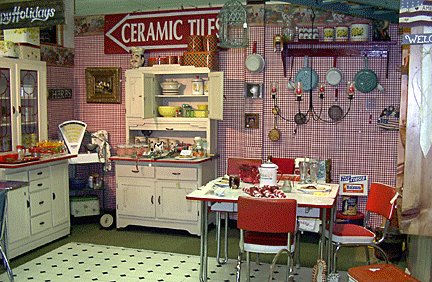 Good display sells antiques. But good display also takes
imagination. Getting a little creative with displays in a shop or mall booth
can do wonders for sales. All it takes is a little time and effort and
little or no money. Good display sells antiques. But good display also takes
imagination. Getting a little creative with displays in a shop or mall booth
can do wonders for sales. All it takes is a little time and effort and
little or no money.
High end antique dealers practice good display because they know that one
expensive piece displayed well has a much better chance of selling than if
it’s mixed in with a jumble of other pieces. Unfortunately, middle and lower
end dealers often follow the concept of the more items displayed, the more
that will sell. Some believe that if they don’t display everything they have
that customers won’t buy if they don’t see an item they’re looking for.
True, antique browsing for many is an enjoyable pastime, but browsing
through attractive displays will often draw attention to items that
otherwise customers would miss altogether.
And with the increased competition in the antique market in recent years,
it’s more important than ever to practice good retail display techniques.
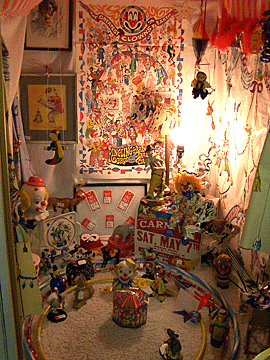 What is the effect of store display on performance? According to Linda Cahan,
author of A Practical Guide to Visual Merchandising, nothing builds business
like a redo of store displays. “Think of it as the ultimate face-lift that
rejuvenates the spirit and energy of the store,” she said. “Customers are
always aware of the difference and studies have proven increased sales after
successful and appropriate changes.” What is the effect of store display on performance? According to Linda Cahan,
author of A Practical Guide to Visual Merchandising, nothing builds business
like a redo of store displays. “Think of it as the ultimate face-lift that
rejuvenates the spirit and energy of the store,” she said. “Customers are
always aware of the difference and studies have proven increased sales after
successful and appropriate changes.”
The late Max Hess, founder of Hess Department Store of Allentown,
Pennsylvania, used to periodically not only change all the displays in his
store but also the direction of the escalators. When customers came off an
escalator, they got an entirely different view of a display—in many cases
they saw it for the first time, encouraging them to buy the items on
display.
Good displays tell the world that dealers care about their image, their
merchandise and most of all, about entertaining, informing and educating
their customers. Customers start to count on seeing displays. If merchandise
stays in the same display too long, it looks old and unwanted. If displays
aren’t changed frequently (at least twice a month), a shop becomes wallpaper
on the street or in a mall.
The look of the displays in a store are directly related to the price of the
merchandise. A junky display conveys a junky image. Even junk can be made to
look good in the right display. Many mall booth and flea market dealers
often feel that because they have a limited space and sell lower priced
items, they don’t have to attract customers. They think that customers will
buy from them because they’re selling lower-end antiques and collectibles.
Customers, even antique shoppers, buy what attracts their attention.
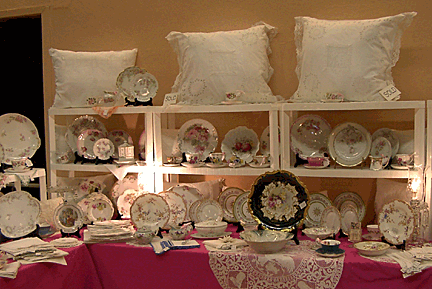 It's difficult to stop busy people in their tracks. Dealers are lucky if
potential customers even notice their shops in their daily travels. To
attract positive attention to a shop or booth, dealers need to have
eye-catching displays. Cahan noted that the five most important design tools
to get people to stop and really look are: Color, Angles, Movement,
Simplicity and/or Repetition and of course, Imagination. Dealers who use a
combination of any two of these will have created a successful display. It's difficult to stop busy people in their tracks. Dealers are lucky if
potential customers even notice their shops in their daily travels. To
attract positive attention to a shop or booth, dealers need to have
eye-catching displays. Cahan noted that the five most important design tools
to get people to stop and really look are: Color, Angles, Movement,
Simplicity and/or Repetition and of course, Imagination. Dealers who use a
combination of any two of these will have created a successful display.
Color is the first element that attracts attention. Black and white with a
bright accent, any monochromatic color combination such as pink tones from
light to dark, reds, bright blues and orange and yellow attract the most.
It’s also effective to combine a neutral with one or two bright colors. When
merchandise is mainly neutral or subdued in tone, bright backgrounds work
best.
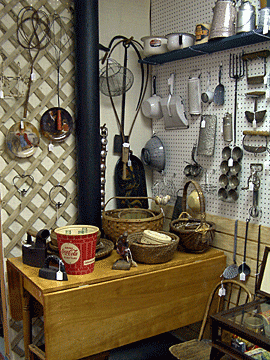 Angles lead a customers eye to wherever a dealer wants them to look. An
angle can be made of many different things such as varying levels of props
and merchandise, accessories fanned from one height down to another, painted
or free hanging graphics, and plants or lights. But dealers should make sure
that whenever they use an angle in a display, that it leads the customer’s
eye to something they want to sell. Angles lead a customers eye to wherever a dealer wants them to look. An
angle can be made of many different things such as varying levels of props
and merchandise, accessories fanned from one height down to another, painted
or free hanging graphics, and plants or lights. But dealers should make sure
that whenever they use an angle in a display, that it leads the customer’s
eye to something they want to sell.
“Humans respond visually to movement just like cats and dogs,” said Cahan.
“When shop owners use movement, we look.” Movement comes in many forms. A
fan blowing lace curtains is easy and inexpensive. Put a train in a window
at Christmas–large LGB trains attract the most attention. Those little
motors that move things back and forth on liquor displays can also be put to
good use in antique displays. They can move accessories, props, scenery—just
about anything.
Movement indicates affordability. It's a crowd pleaser and the "elite" do
not consider themselves part of the crowd. For dealers selling higher-end
antiques, movement should be perceived rather than actual. Angles create
movement in the perceptual sense.
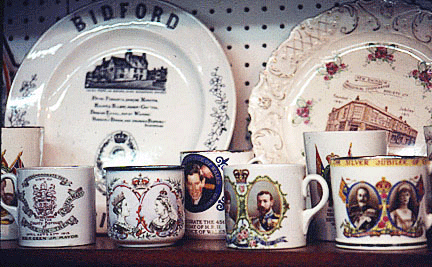 Repetition is another way to attract attention. Dealers can have fun with
repetition by allowing one of the repeated props or items to be slightly
askew or offset with an unusual prop or accessory. Remember, when putting a
number of items in a display, odd numbers are always more dynamic and
interesting than evens. Repetition is another way to attract attention. Dealers can have fun with
repetition by allowing one of the repeated props or items to be slightly
askew or offset with an unusual prop or accessory. Remember, when putting a
number of items in a display, odd numbers are always more dynamic and
interesting than evens.
“Imagination is what sets the good apart from the great,” said Cahan.
Dealers should look at interesting and imaginative displays in other shops
and adapt those ideas to suit themselves.
Props are another way to add interest to displays. Antique dealers have the
advantage of having interesting props right in their own inventory. But
sometimes non-antique props such as ladders, fences, and architectural
elements need to be used.
Antiques often suggest different display ideas by their end use or former
usage. Each of these ideas can influence prop selection.
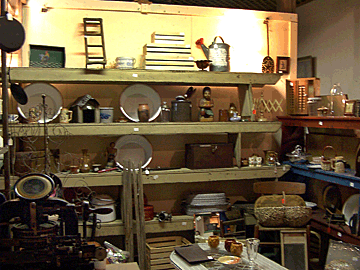 Props also help to draw attention to a display but shouldn’t overwhelm the
merchandise being displayed. The point is to enhance, not hide the
merchandise. Sometimes a selection of items will help decide what sort of
prop to use. At other times a prop may suggest what sort of items to
display–an old stove may suggest a display of kitchenware. Props also help to draw attention to a display but shouldn’t overwhelm the
merchandise being displayed. The point is to enhance, not hide the
merchandise. Sometimes a selection of items will help decide what sort of
prop to use. At other times a prop may suggest what sort of items to
display–an old stove may suggest a display of kitchenware.
One way to discover great props is at the same place dealers find their
merchandise—at tag or garage sales. Anything can make an interesting
prop--old mantle pieces, empty frames, garden equipment that can be painted
in bright or neutral colors--in fact anything can be painted to look
sculptural. Antique signs or photographs enhance the look of a period. These
are called "found object props" and outside of tag sales, dealers may find
all sorts of things in basements, attics, on the street, or in flea markets.
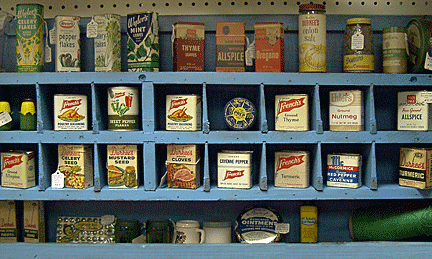 The local home improvement center is a goldmine of props. Think about all
the potential uses for clothesline, buckets, ladders, nails and wood,
utility lights, tiles, terra cotta pots, brooms, snow shovels, etc. Consider
borrowing props from neighboring shop owners. The local home improvement center is a goldmine of props. Think about all
the potential uses for clothesline, buckets, ladders, nails and wood,
utility lights, tiles, terra cotta pots, brooms, snow shovels, etc. Consider
borrowing props from neighboring shop owners.
Many stores will loan merchandise for window credits. Consider unusual
sporting goods such as rafts, tents, archery, croquet, golf, racquetball or
polo. A boating store may loan you a sunfish or rowboat if your window is
really large. Try a fencing company for colorful fences or a local florist
for beautiful dried flower arrangements or wreaths. A credit can go a long
way. The lender gets extra attention and appreciation from a whole new
customer base.
Last, but equally important, is the use of art as a prop. Many local artists
would be thrilled to show their work in a good display. But dealers should
be careful not to cover it with their merchandise. Again, a credit is a
must. Dealers can also use old paintings and prints.
Some inexpensive prop ideas include feathers, beach balls, flower pots,
ribbon, big balls of colorful yarn, and copies of any interesting graphic
image repeated over and over on a back wall.
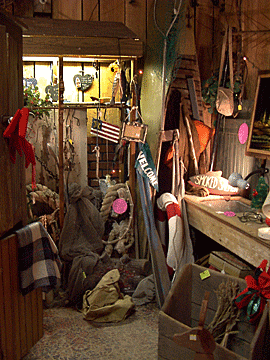 Ken Silveri of Hawks Bill Antiques of Hamburg, Pennsylvania, found that a
pair of orchard ladders worked well to display his selection of
Staffordshire ware. Vernon Shephard of Treasure Hill Antique Co-op in
Morgantown, Pennsylvania, piled up old wooden benches to create a dramatic
booth display. Barbara Hove, also of Treasure Hill, used part of an old
hutch to display household collectibles. Other dealers use wooden folding
dish drainers to display souvenir plates. Ken Silveri of Hawks Bill Antiques of Hamburg, Pennsylvania, found that a
pair of orchard ladders worked well to display his selection of
Staffordshire ware. Vernon Shephard of Treasure Hill Antique Co-op in
Morgantown, Pennsylvania, piled up old wooden benches to create a dramatic
booth display. Barbara Hove, also of Treasure Hill, used part of an old
hutch to display household collectibles. Other dealers use wooden folding
dish drainers to display souvenir plates.
Lighting can make or break a display. Dealers should use a mixture of spots
and area lighting from older lamps. This is especially important when
selling furniture or glassware. The warmth of residential lighting will add
a lot to the atmosphere, while spots will highlight particular groupings.
Creating periodic themed displays encourages customers to come back often to
look at them and to buy. Themes can be based on seasons of the year,
holidays, time periods, events, anything that offers a chance to group the
same merchandise in new ways. Flags and bunting can create a bright,
patriotic display for Memorial Day to Independence Day or for election day.
And many shop owners decorate for Christmas. By creating special themed
Christmas displays–such as gifts for the antique collector–a dealer can
actually give ideas to customers who don’t know what to get that special
person on their gift list.
Dealers can get ideas for displays in any number of places. They can check
out the displays in other stores—and not just antique shops. They can look
at stores whose style and image reflect what they’re trying to achieve with
their shop. They can also study the ads in home and garden magazines. These
ads themselves are lessons in balance, design and how to use space.
Good displays sell antiques. Great displays attract customers.
<
Back to
Antiques Articles
Go to the next antiques article > |
|
